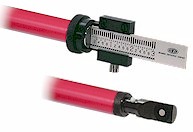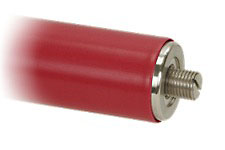About Invar
Minimize thermal changes with "Invar"
Everyone knows that almost all materials will expand when the temperature rises, and shrink when the temperature falls. Often this is not a problem, but in the measurement world, this effect can cause mischief. Nobody likes to measure things with a ruler that is capable of expanding and contracting. It's the same as the old story about the man with two watches – he never knows what time it really is. So wouldn't it be great to have a measuring device that was the same length regardless of the temperature?
It sure would! We come close to that scenario by using "Invar". Invar is a very special alloy of iron and nickel, with a few other things thrown in, such as silicon and manganese. The benefit of Invar is that it has a very low coefficient of thermal expansion. This of course means that it changes very little when the temperature rises or falls. In fact, the alloy gets its name from the fact that it has a relatively invariant volume under varying temperatures.
So what are the numbers? Well, for example, a piece of aluminum which is 5 feet long would change about 0.024 inch in length over a 30 degree Fahrenheit temperature change. A piece of steel the same length would change about 0.017 inch for the same temperature change. However, compare those numbers with Invar, which would change in length only 0.001 inch under the same conditions. It's no wonder that we chose to make our length standards and scale extension kits out of something so Invariant!
[To be specific, the thermal coefficient of expansion of the Invar used in our Invar system components is 0.68 x 10−6 in./in.°F over a range of 0-200°F. In metric units, this is 1.2 x 10−6 m/m°C.]
Why Brunson's Invar system is so cool!
We know that measurement professionals always try to push the envelope of accuracy as far as practical and/or possible. It also seems like everything works against this goal – things like vibration, air movement, or inherent equipment limitations. We know that any time an obstacle can be minimized, it can be a significant factor in making positive and accurate measurements or alignments. That's why we used Invar as the material for our scale extensions and length standards. Its low coefficient of thermal expansion (see above) makes it the perfect material for the job.
 To make your job as easy as possible, we designed a flexible system which allows you to use a variety of standard components to configure a number of different measuring tools. For example, these tools can be used to construct scale extensions of various lengths for optical alignment applications. Various end tips are available to accommodate different types of nominal reference positions. Or the system can be used to construct known and trusted distances between targets for the calibration sequences required by laser trackers, scanners, photogrammetry systems, theodolite systems, etc.
To make your job as easy as possible, we designed a flexible system which allows you to use a variety of standard components to configure a number of different measuring tools. For example, these tools can be used to construct scale extensions of various lengths for optical alignment applications. Various end tips are available to accommodate different types of nominal reference positions. Or the system can be used to construct known and trusted distances between targets for the calibration sequences required by laser trackers, scanners, photogrammetry systems, theodolite systems, etc.
The Three "Cs"
The Brunson Invar System is a simple system of Invar tubing and accessories, designed with three "Cs" in mind: Connection, Calibration, and Certification.

- Connection: All of our Invar system components are designed to be connected together using standard, removable threaded plugs. Bars of different lengths may be connected together, yielding any desired length. Various terminators such as tooling balls or concave tips, as well as scale holders and target holders may be connected on one or both ends of the bar. The mating surfaces of all components are machined to tight parallelism tolerances to assure you of a precision fit.
- Calibration: All dimensional components of our Invar system are serialized and accurately measured – and you're provided with a document specifying the precise length of each item by serial number.
- Certification: All calibrated components are certified as NIST-traceable with included documentation.
Flexibility
Because our Invar System is so flexible, it is well-suited for several different applications:
- Precision scale offsets (extensions)
- Three dimensional measurement system scaling (trackers, photogrammetry, theodolites, etc.)
- Hidden point rods
- Provide known reference lengths for calibration
- Construction of invariant artifacts


